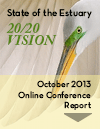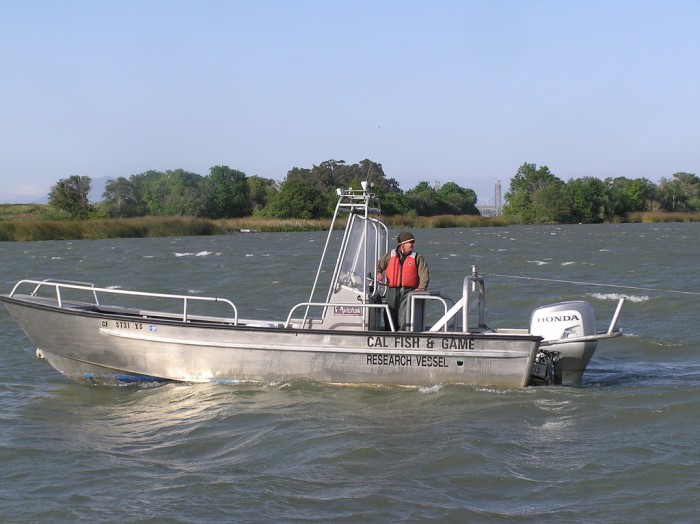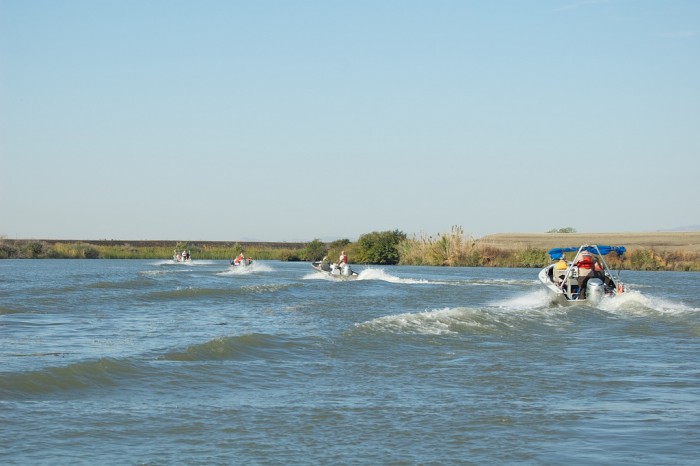
 Using science to make good management decisions in the Delta has never been straightforward. To begin with, there are a lot of different flavors – from stakeholder science to agency science to federal, state or university science, and the kind of science used in courtrooms. There’s also the complexity of any science related to a dynamic aquatic system, and the high stakes of any science used to justify taking scarce water away from one user and giving it to another. Synthesis and coordination of all the science has been a priority for decades now, but hasn’t yet reached the threshold of clarity that everyone seems to be waiting for. Just how much science do we need, then, for California to feel comfortable investing in big, expensive upgrades to Delta habitats and infrastructure?
Using science to make good management decisions in the Delta has never been straightforward. To begin with, there are a lot of different flavors – from stakeholder science to agency science to federal, state or university science, and the kind of science used in courtrooms. There’s also the complexity of any science related to a dynamic aquatic system, and the high stakes of any science used to justify taking scarce water away from one user and giving it to another. Synthesis and coordination of all the science has been a priority for decades now, but hasn’t yet reached the threshold of clarity that everyone seems to be waiting for. Just how much science do we need, then, for California to feel comfortable investing in big, expensive upgrades to Delta habitats and infrastructure?
Such questions were no doubt on the minds of those in the room for the Wednesday afternoon session on the Delta Science Plan. The Delta Stewardship Council approved this plan in October 2013, just before the conference, Peter Goodwin explained after stepping to the podium. Goodwin is the top scientist for the Delta Science Program. “The science program doesn’t do science, it facilitates science,” he explained.

The Program’s new plan lays out a vision for One Delta, One Science—an open Delta science community that works together to build a shared body of scientific knowledge. The idea is to help differentiate between genuine disagreements about what the data tell us from uncertainties associated with the information. Once that’s sorted out, the Delta Science Plan suggests ways to collaboratively reduce uncertainties until tradeoffs among alternative actions become clear.
“The current organization is inadequate; collaborative science is a better [approach],” said Goodwin. “The challenge is, as the knowns grow, so do the unknowns. That’s why our plan provides a menu of decision tools, including papers, panels, and workshops. Synthesis figures heavily throughout.”
Goodwin yielded the microphone to Delta Science Program manager Rainer Hoenicke, who introduced a panel of prominent Delta science producers and users to discuss how to move forward with a joint science agenda. Hoenicke began by commending several current programs for providing an excellent foundation for increased collaboration, citing the Interagency Ecological Program, California Fish and Wildlife’s Ecosystem Restoration Program, the California Water Quality Monitoring Council, and a series of synthesis workshops sponsored by the State Water Resources Control Board, among others. Despite the close working relationships of many individual scientists and coordinated efforts, it is difficult to track all activities related to data generation, model development and calibration, new results, and insights gained, he said. Hoenicke was confident, however, that the new science plan would create a shared process for prioritizing research, managing conflict, building trust, synthesizing science, and advancing the state of knowledge for the San Francisco Estuary and its watershed.
Hoenicke asked the panel to comment on how to make science-based adaptive management more effective. Adaptive management was conceived in the 1970s to provide for management in the face of uncertainties and new information, explained panelist Anke Mueller-Solger, lead scientist for the IEP. The process often starts off well, but fails when those attempting it don’t have means or time to complete the final phases of evaluation and adaption. “We need a way to close the loop,” she said.
The next panelist, Mike Chotkowski of the U.S. Fish and Wildlife Service, had this perspective: “The problem in the Delta is that scientists don’t agree on the facts, on the uncertainties, or how to move forward.” Economic and ideological positions tend to distort the science, he said, citing new opinion surveys (see Delta Economics story). “If we are to succeed with one science, we must move away from managers and stakeholders. We need a science establishment that can bring all sides together,” he said.

The relationship between stakeholders and science has always been problematic, especially when it comes to endangered species management. “The process of remand of biological opinions shows disagreement over facts,” said the next panelist, Carl Wilcox of the California Department of Fish and Wildlife. “The challenge is to find ways to overcome these disagreements using the Science Plan processes.”
Many disagreements derive from uncertainties, and uncertainty helps maintain the status quo, even if it isn’t working. “Managers don’t do a good job of communicating gaps and needs to scientists,” said the next panelist, Maria Rea of NOAA Fisheries. “We need to help researchers focus on the most relevant issues, and provide safe places for scientific debate—out of courtrooms,” she said. “Science cannot give us all the answers. We also need to better communicate the underlying legal structure that guides agency decision making.”
Money also plays a role in how science is used to make management decisions. The good scientific research and analysis required to set priorities often requires significant funding, said panelist Paul Helliker of the California Department of Water Resources (DWR). Together, DWR, the U.S. Bureau of Reclamation, and their water users fund the lion’s share of Delta science, but this expense competes with other priorities. “We need more coalitions and collaboration [to get by], but trust is not great between agencies, and between agencies and stakeholders,” said panelist Sue Fry of Reclamation. “Agencies must model trust for stakeholders, and build coalitions using the open nature of the Science Plan. We need a mutual understanding of our end points.”
The U.S. Geological Survey’s Lee Case agreed that collaboration must be fostered both “internally and externally.” Many scientists are also concerned about federal and state funding cuts punching holes in important data sets used for management. Snapshots aren’t good enough to answer questions over time, he said, so scientists need to anticipate and communicate what’s ahead, rather than just focusing on writing up end results. “We need new ways of doing research that can help us simplify and communicate a very complex system,” said Case.
Hoenicke then asked the panel to share their priorities for science action. Wilcox felt priorities should be issues in court: spring outflow and longfin smelt. Rea’s priority was the low survival rate of outmigrating salmonids. “We don’t have good life cycle models, or good synthesis of how to use tools like salinity, temperature and flows” to help the fish, she said.
Chotowski got the last word in, on sustaining Delta science over the long term: “It’s hard to address complex issues without adequate resources. Agencies tend to answer science questions that are relevant to immediate management needs but not invest in answering the hard, big-picture questions about how the Estuary works.”
Delta Science Plan
[toggle_box]
[toggle_item title=”PowerPoint Gallery” active=”false”]
[/toggle_item] [/toggle_box]
By Ariel Rubissow Okamoto

Nothing could be stranger than sitting in the dark with thousands of suits and heels, watching a parade of promises to decarbonize from companies and countries large and small, reeling from the beauties of big screen rainforests and indigenous necklaces, and getting all choked up.
It was day two of the September 2018 Global Climate Action Summit in San Francisco when I felt it.
At first I wondered if I was simply starstruck. Most of us labor away trying to fix one small corner of the planet or another without seeing the likes of Harrison Ford, Al Gore, Michael Bloomberg, Van Jones, Jerry Brown – or the ministers or mayors of dozens of cities and countries – in person, on stage and at times angry enough to spit. And between these luminaries a steady stream of CEOs, corporate sustainability officers, and pension fund managers promising percentages of renewables and profits in their portfolios dedicated to the climate cause by 2020-2050.
I tried to give every speaker my full attention: the young man of Vuntut Gwichin heritage from the edge of the Yukon’s Arctic National Wildlife Refuge who pleaded with us not to enter his sacred lands with our drills and dependencies; all the women – swathed in bright patterns and head-scarfs – who kept punching their hearts. “My uncle in Uganda would take 129 years to emit the same amount of carbon as an American would in one year,” said Oxfam’s Winnie Byanyima.
“Our janitors are shutting off the lights you leave on,” said Aida Cardenas, speaking about the frontline workers she trains, mostly immigrants, who are excited to be part of climate change solutions in their new country.
The men on the stage, strutting about in feathers and pinstripes, spoke of hopes and dreams, money and power. “The notion that you can either do good or do well is a myth we have to collectively bust,” said New Jersey Governor Phil Murphy whose state is investing heavily in offshore wind farms.
“Climate change isn’t just about risks, it’s about opportunities,” said Blackrock sustainable investment manager Brian Deese.
But it wasn’t all these fine speeches that started the butterflies. Halfway through the second day of testimonials, it was a slight white-haired woman wrapped in an azure pashmina that pricked my tears. One minute she was on the silver screen with Alec Baldwin and the next she taking a seat on stage. She talked about trees. How trees can solve 30% of our carbon reduction problem. How we have to stop whacking them back in the Amazon and start planting them everywhere else. I couldn’t help thinking of Dr. Seuss and his truffala trees. Jane Goodall, over 80, is as fierce as my Lorax. Or my daughter’s Avatar.
Analyzing my take home feeling from the event I realized it wasn’t the usual fear – killer storms, tidal waves, no food for my kids to eat on a half-baked planet – nor a newfound sense of hope – I’ve always thought nature will get along just fine without us. What I felt was relief. People were actually doing something. Doing a lot. And there was so much more we could do.
As we all pumped fists in the dark, as the presentations went on and on and on because so many people and businesses and countries wanted to STEP UP, I realized how swayed I had let myself be by the doomsday news mill.
“We must be like the river, “ said a boy from Bangladesh named Risalat Khan, who had noticed our Sierra watersheds from the plane. “We must cut through the mountain of obstacles. Let’s be the river!”
Or as Harrison Ford less poetically put it: “Let’s turn off our phones and roll up our sleeves and kick this monster’s ass.”
by Isaac Pearlman
Since California’s last state-led climate change assessment in 2012, the Golden State has experienced a litany of natural disasters. This includes four years of severe drought from 2012 to 2016, an almost non-existent Sierra Nevada snowpack in 2014-2015 costing $2.1 billion in economic losses, widespread Bay Area flooding from winter 2017 storms, and extremely large and damaging wildfires culminating with this year’s Mendocino Complex fire achieving the dubious distinction of the largest in state history. California’s most recent climate assessment, released August 27th, predicts that for the state and the Bay Area, we can expect even more in the future.
The California state government first began assessing climate impacts formally in 2006, due to an executive order by Governor Schwarzenegger. California’s latest iteration and its fourth overall, includes a dizzying array of 44 technical reports; three topical studies on climate justice, tribal and indigenous communities, and the coast and ocean; as well as nine region-specific analyses.
 The results are alarming for our state’s future: an estimated four to five feet of sea level rise and loss of one to two-thirds of Southern California beaches by 2100, a 50 percent increase in wildfires over 25,000 acres, stronger and longer heat waves, and infrastructure like airports, wastewater treatment plants, rail and roadways increasingly likely to suffer flooding.
The results are alarming for our state’s future: an estimated four to five feet of sea level rise and loss of one to two-thirds of Southern California beaches by 2100, a 50 percent increase in wildfires over 25,000 acres, stronger and longer heat waves, and infrastructure like airports, wastewater treatment plants, rail and roadways increasingly likely to suffer flooding.
For the first time, California’s latest assessment dives into climate consequences on a regional level. Academics representing nine California regions spearheaded research and summarized the best available science on the variable heat, rain, flooding and extreme event consequences for their areas. For example, the highest local rate of sea level rise in the state is at the rapidly subsiding Humboldt Bay. In San Diego county, the most biodiverse in all of California, preserving its many fragile and endangered species is an urgent priority. Francesca Hopkins from UC Riverside found that the highest rate of childhood asthma in the state isn’t an urban smog-filled city but in the Imperial Valley, where toxic dust from Salton Sea disaster chokes communities – and will only become worse as higher temperatures and less water due to climate change dry and brittle the area.
According to the Bay Area Regional Report, since 1950 the Bay Area has already increased in temperature by 1.7 degrees Fahrenheit and local sea level is eight inches higher than it was one hundred years ago. Future climate will render the Bay Area less suitable for our evergreen redwood and fir forests, and more favorable for tolerant chaparral shrub land. The region’s seven million people and $750 billion economy (almost one-third of California’s total) is predicted to be increasingly beset by more “boom and bust” irregular wet and very dry years, punctuated by increasingly intense and damaging storms.
Unsurprisingly, according to the report the Bay Area’s intensifying housing and equity problems have a multiplier affect with climate change. As Bay Area housing spreads further north, south, and inland the result is higher transportation and energy needs for those with the fewest resources available to afford them; and acute disparity in climate vulnerability across Bay Area communities and populations.
“All Californians will likely endure more illness and be at greater risk of early death because of climate change,” bluntly states the statewide summary brochure for California’s climate assessment. “[However] vulnerable populations that already experience the greatest adverse health impacts will be disproportionately affected.”
“We’re much better at being reactive to a disaster than planning ahead,” said UC Berkeley professor and contributing author David Ackerly at a California Adaptation Forum panel in Sacramento on August 27th. “And it is vulnerable communities that suffer from those disasters. How much human suffering has to happen before it triggers the next round of activity?”
The assessment’s data is publicly available online at “Cal-adapt,” where Californians can explore projected impacts for their neighborhoods, towns, and regions.
